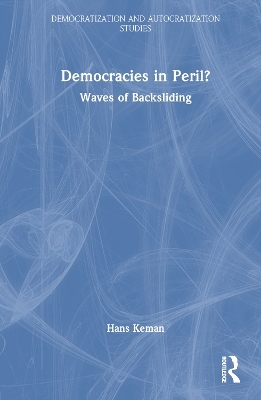
Democracies in Peril?
Routledge (Verlag)
978-1-032-02990-0 (ISBN)
This insightful text rigorously examines and accounts for contemporary developments – and crucially a reversal of “democraticness” – in democratic polities and related political processes comparing 38 democracies across the world. The focus is on contemporary developments and recent volatile levels of democraticness.
Democracies in Peril? introduces theoretical backgrounds of what makes democracy tick and scrutinises empirical trends and development in “democraticness” in an accessible manner. It explores what “democracy” as a political regime implies and how the liberal democratic model developed, as well as examining the present state of affairs in democracies, the challenges democracies encounter and the perils of democracy as a legitimate system of governance in the 21st century. The book provides a “systemic” approach to adjudicate the effects of this assumed reversal in democratisation in terms of popular preferences, party behaviour, institutional architecture and policy performance. The effects of public policy formation and the role of the state on actual democratic performance are also analysed.
Finally, case studies on the Covid pandemic and the development of social welfare demonstrate the complex relationship between government capacities – under pressure – and the quality of democracy, approaching the question: How do 38 democratic states cope with societal problems, populist tendencies and a fast-changing world without degrading their institutional quality and legitimacy?
This text will be of key interest to students, scholars, journalists and interested readers of comparative politics, democratisation, public administration, political economy, constitutional law and the social sciences in general.
Hans Keman is Professor Emeritus of Comparative Political Science at the Vrije Universiteit Amsterdam (VU Amsterdam), the Netherlands.
List of tables
List of figures
List of boxes
Preface
1 Prologue: democracy in the 21st century
1.1 Democracies in peril: backsliding and de-democratisation
1.2 The concept of democraticness: proto-types
1.3 Levels of democraticness: the yard-stick for comparison
1.4 The storyline as a “road trip”: democratisation and political decay
1.5 Value-free and value-related knowledge: a realist position
PART 1
Studying democracy: detecting flaws, defects and perils
2 Reversing trends in “democraticness”
2.1 Democracy in peril?
2.2 Are “full” democracies indeed reverting?
2.3 Full democracies in contrast to flawed and defective democracies
2.4 Perilous developments: potential reasons and questions to ask
3 Comparative political science and the study of democracy
3.1 The academic debate: room for improvement
3.2 Omissions in the study of democratic politics
3.3 Comparing democratic states: full, flawed and defective polities
4 Thinking about democracy: the origins of the liberal model
4.1 From ideas to design
4.2 The enlightenment and the concept of the democratic state
4.3 John Stuart Mill and liberal democracy
4.4 The roots of liberal democracy laid out: still work in progress
PART 2
Pathways towards liberal Democratisation
5 Designing liberal democracy: institutionalising the polity
5.1 Constitutional trajectories toward “representative” governance
5.2 Missing dimensions, institutional progress and constraints
5.3 The shaping of the polity towards liberal democracy
5.4 Considerations on the road to liberal democratisation
6 Towards universal suffrage and representation of the people
6.1 Electoral inclusiveness and fair representation
6.2 Finding the optimal solution to fair and effective representation
6.3 The effects of electoral systems: inclusiveness and pluriform representation
6.4 Institutional engineering: the choice of an optimal electoral system
7 Who governs at the end of the day in a democracy?
7.1 Power distribution and indirect democracy: inevitable or containable?
7.2 Democracy and selected leadership: the role of political elites
7.3 Indirect democracy: selecting accountable leadership
7.4 Elitism versus pluralism: power concentration or dispersion?
7.5 The scope and limits of liberal democracy
PART 3
Contemporary approaches to the development of democracy 97
8 Polyarchy and pluralism: waves of democratisation
8.1 Polyarchy: the route to “full” democracy?
8.2 Pathways of democratisation: sequences towards polyarchy
8.3 Waves of democratisation: path dependencies and critical junctures
8.4 The second wave of democratisation and reversal (1920–1939)
8.5 Post-war waves towards polyarchy and beyond
8.6 Conceptual considerations on polyarchy
9 Consensus democracy: the alternative to polyarchy?
9.1 Cleavage theory and the coming about of consensus democracy
9.2 Institutional engineering a peaceful polity: consensus democracy
9.3 Consensus democracy and a better and kinder society
9.4 Considerations on the theory of consensus democracy
10 Parties and democracy: does politics matter?
10.1 Politics – polity – policy and democracy
10.2 Complexities of democracy: political parties and policy performance
10.3 Electoral politics and parties in competition and government
10.4 To what extent does democratic politics matter?
PART 4
The liberal model as a yardstick of full democracy?
11 Ranking the stars of democraticness
11.1 The end of history or political decay?
11.2 Liberal democracy: the paradigm to follow? Ranking the stars
11.3 The state of democracy in the 21st century
11.4 Towards fuller democracies or the end of the liberal model?
12 The limits of the liberal democratic model
12.1 From liberal to full democracy? Variations of democraticness
12.2 The paradigm of liberal democracy contested: toward a fuller democracy?
12.3 Challenging liberal democracy: reforming the system
12.4 The state of the liberal model: embeddedness or moving away?
12.5 The limits to liberal democracy
13 Signs of backsliding: illiberalism and populism
13.1 “Illiberalism” and “anti-pluralism” and the level of democraticness
13.2 Anti-pluralism and the impact of populism
13.3 The growth of anti-democratic tendencies: illiberalism and populism
13.4 Backsliding towards defective democracy
PART 5
Liberal democracy, the national state and governing society
14 Macro-politics and micro-performance of the “state”
14.1 The problem-solving capability of the democratic state
14.2 Public policy formation: political choice and policy performance
14.3 Trust is hard to gain but easy to lose: output legitimacy
15 Liberal democracy, legitimacy and stateness: micro performance
15.1 Democratic politics, public policy and societal performance
15.2 The crisis-solving capacity of democratic state: coping with a pandemic
15.3 Avoiding misery, inequalities and the pursuit of happiness?
15.4 The democratic advantage and effective stateness as a sine qua non
16 Legitimacy and the liberal democratic state in the 21st century
16.1 Democracy and the state: entering a new age
16.2 Trust and confidence in institutions
16.3 The rise of social media and its role in politics and society
16.4 The battle for the people: mainstream party politics in disregard
16.5 The shift to provocative parliamentarism: harbouring populist illiberalism
17 Epilogue: backsliding into the 21st century: outmoded or viable and resilient?
17.1 Liberal democracy: state of affairs
17.2 Fear for autocratisation: institutional decay and anti-democratic ethos
17.3 Positive conditions and negative consequences of democraticness
Index
| Erscheinungsdatum | 21.12.2023 |
|---|---|
| Reihe/Serie | Democratization and Autocratization Studies |
| Zusatzinfo | 22 Tables, black and white; 10 Line drawings, black and white; 1 Halftones, color; 1 Illustrations, color; 10 Illustrations, black and white |
| Verlagsort | London |
| Sprache | englisch |
| Maße | 156 x 234 mm |
| Gewicht | 1300 g |
| Themenwelt | Recht / Steuern ► Allgemeines / Lexika |
| Recht / Steuern ► EU / Internationales Recht | |
| Sozialwissenschaften ► Politik / Verwaltung ► Politische Systeme | |
| Sozialwissenschaften ► Politik / Verwaltung ► Staat / Verwaltung | |
| Sozialwissenschaften ► Politik / Verwaltung ► Vergleichende Politikwissenschaften | |
| Wirtschaft ► Volkswirtschaftslehre ► Wirtschaftspolitik | |
| ISBN-10 | 1-032-02990-0 / 1032029900 |
| ISBN-13 | 978-1-032-02990-0 / 9781032029900 |
| Zustand | Neuware |
| Informationen gemäß Produktsicherheitsverordnung (GPSR) | |
| Haben Sie eine Frage zum Produkt? |
aus dem Bereich


